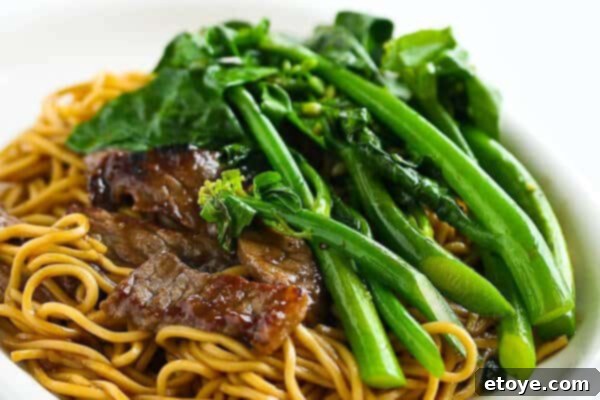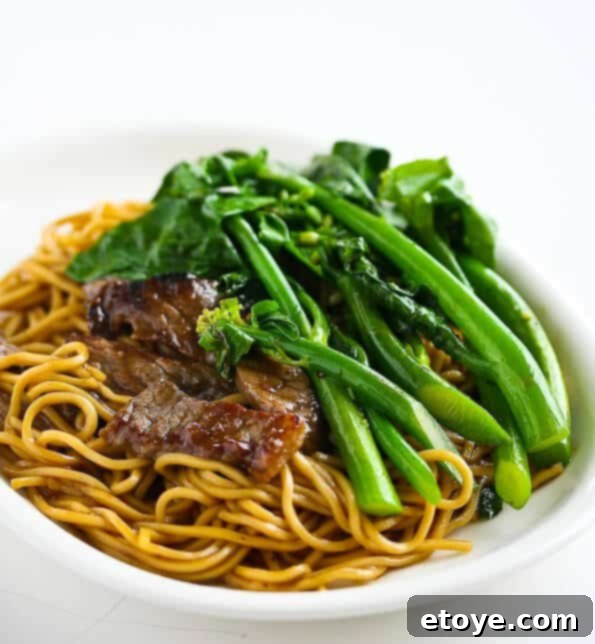
Mastering the Art of Chinese Broccoli Beef Noodle Stir Fry: A Comprehensive Guide
Embark on a culinary journey to create the ultimate Chinese Broccoli Beef Noodle Stir Fry, a dish that perfectly balances savory beef, vibrant gai-lan, and tender noodles. This comprehensive guide will transform your home cooking, revealing secrets to achieving restaurant-quality flavor and texture. Get ready to elevate your stir-frying game and impress your family and friends with this beloved Asian classic, ideal for a quick weeknight meal or a special weekend treat.
Here’s what you'll uncover in this in-depth guide:
- Expert tips on selecting the freshest Chinese broccoli (gai-lan) for optimal taste and texture.
- The definitive marinade recipe that guarantees exceptionally tender and flavorful beef every time.
- Professional techniques for executing flawless Chinese stir-fries, ensuring perfect caramelization and crisp vegetables.
- Guidance on choosing the best noodles for your stir-fry and achieving their ideal texture.
- Step-by-step instructions for a seamless cooking experience from preparation to plate.
- Insights into common stir-fry pitfalls and how to easily avoid them, ensuring culinary success.
The Star Green: Chinese Broccoli (Gai-Lan) Demystified
Chinese broccoli, widely known as gai-lan, is a cherished vegetable in authentic Asian cuisine, revered for its unique flavor profile—a delightful blend of slight bitterness harmonized with a subtle sweetness and a satisfying crunch. The foundation of a truly exceptional stir-fry begins with selecting the freshest gai-lan. When shopping, prioritize stalks that are predominantly stem, adorned with lush, deep green leaves. It’s crucial to seek out gai-lan with minimal, if any, open white flowers. An abundance of open blossoms is a clear indication that the vegetable has passed its peak freshness, often leading to a tougher texture and an unpleasantly bitter taste that can overpower your dish.
Another telling sign of superior gai-lan freshness lies in the appearance of its cut stems. Take a moment to examine the bottoms of the stalks: they should exhibit a milky-translucent quality and a smooth surface. This characteristic is a hallmark of youth and tenderness, promising a more enjoyable eating experience. Conversely, if you notice a hard, distinct white circle in the center of the cut stem, it's a strong indicator that the gai-lan is older, suggesting a potentially tough and noticeably bitter flavor. By meticulously choosing fresh gai-lan, you guarantee that your stir-fry will feature bright, crisp greens that flawlessly complement the tender, marinated beef, adding both visual appeal and a burst of fresh flavor.
The image below illustrates perfectly fresh Chinese Broccoli with desirable stem-bottoms, highlighting the milky-translucent cut ends:
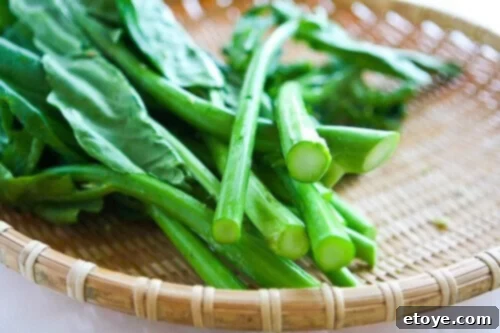
Choosing Your Noodles: A Foundation of Flavor and Texture
The inherent beauty of this Broccoli Beef Noodle Stir Fry recipe lies in its remarkable adaptability, particularly when it comes to your choice of noodles. While many traditionalists might gravitate towards authentic Chinese egg noodles, do not feel constrained by convention. This dish welcomes a broad spectrum of noodle varieties. You can achieve excellent results with everyday spaghetti noodles, the broad, flat profiles of rice noodles, or even the distinct chewiness of Japanese-style egg noodles, as I opted for in this particular preparation. The overarching principle is to select a noodle type that possesses the structural integrity to absorb the rich, savory sauce without succumbing to mushiness during the stir-frying process.
Regardless of your chosen noodle, always adhere to the cooking instructions provided on its package, but with one pivotal modification: aim for an al dente texture, or even slightly undercooked by approximately one minute. This deliberate undercooking is a strategic move. The noodles are destined to complete their cooking cycle directly in the hot wok, where they will eagerly soak up all the delectable flavors from the sauce. This final cooking stage prevents them from becoming overcooked and soft, ensuring they retain a delightful chewiness that significantly enhances the overall mouthfeel and enjoyment of the entire dish. This meticulous attention to noodle texture is a key element in achieving a truly authentic and satisfying stir-fry experience.

The Secret to Tender Beef: Crafting the Perfect Marinade
Achieving beef that is incredibly tender and flavorful is a defining characteristic of an outstanding stir-fry, and its genesis lies squarely in the marinade. While your chosen noodles are gently simmering, seize this ideal moment to meticulously prepare your beef slices. The marinade concocted for this dish is a masterful blend, meticulously designed to achieve a dual purpose: it both tenderizes the meat to an exquisite degree and infuses it with profound layers of umami flavor. This potent mixture typically comprises a balanced trifecta of soy sauce, which imparts essential saltiness and foundational depth; cornstarch, serving as a tenderizer that also creates a protective, silky coating; and a touch of sugar, critically aiding in the beef's caramelization during cooking. Further enhancing this blend are rich oyster sauce, which contributes a savory sweetness, and a splash of rice wine, providing an aromatic lift and complex notes.
Should authentic Shaoxing rice wine prove elusive, do not despair; dry sherry or any good quality dry white wine serves as an excellent, readily available substitute, imparting a remarkably similar complex flavor profile. The interplay between the sugar and oyster sauce is particularly vital, as they actively participate in the Maillard reaction, a chemical process responsible for promoting those coveted beautiful, deep brown caramelized spots on the beef's exterior during stir-frying. This caramelization not only enhances visual appeal but also contributes an irresistible depth of flavor. Allow the beef to luxuriate in this marinade for at least 20 minutes; this sufficient marination time allows all these thoughtfully selected ingredients to fully exert their magical influence, transforming humble beef slices into stir-fry perfection.

Unlocking Stir-Fry Mastery: The Art of Caramelization and High Heat
Do you aspire to achieve stir-fried beef with those highly sought-after, beautifully caramelized edges that tantalize the palate? The cornerstone of this culinary achievement rests upon a fundamental, yet frequently overlooked, principle: **never overcrowd your pan!** This singular rule is absolutely critical for cultivating that desirable deep brown crust and, more importantly, ensuring your beef is properly seared rather than merely steamed. When an excessive quantity of meat is introduced into a hot wok or frying pan, the temperature plummets precipitously. This rapid drop in heat, coupled with the immediate release of moisture from the beef, actively impedes the crucial Maillard reaction, preventing proper browning. Instead of developing a rich, flavorful crust, the beef will simply simmer in its own exuded juices, resulting in a lackluster, grey appearance and a significantly less flavorful, often tougher, texture.
The true artistry lies in cooking the beef in manageable batches, ensuring each piece is arranged in a single, uncrowded layer. This strategic spacing allows every individual slice ample opportunity for direct, unhindered contact with the intensely hot cooking surface of the wok. Once you've carefully placed the beef into your screaming hot wok or frying pan, the next vital step is to exercise profound patience and **leave it completely undisturbed**. Resolutely resist the instinctive urge to shake the pan, haphazardly move the beef around, or flip it prematurely. Grant the first side sufficient time to develop a rich, golden-brown caramelization, typically a period of 1 to 2 minutes, before you gently flip each piece to meticulously sear the opposing side. This deliberate waiting period is precisely where the transformative magic unfolds, orchestrating the creation of those delightful, crispy, flavor-packed bits that contribute an incredible depth of taste and varied texture to your finished stir-fry. Embracing this disciplined approach guarantees beef that is not only tender but also infused with profound, complex flavors.
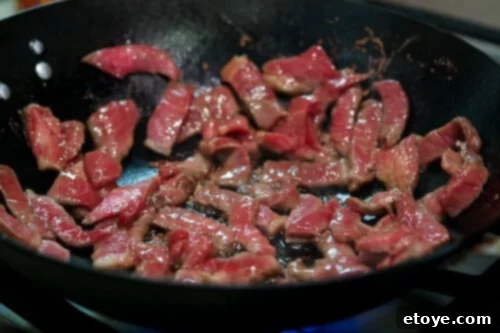
Observe the exquisite caramelization along the edges and surfaces of these beef slices, a testament to proper searing technique:
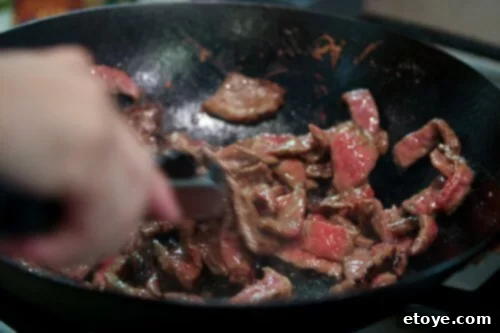
These beautifully caramelized bits are more than just visually appealing; they are critical contributors to the profound depth of flavor in your final dish. Once the beef has achieved your desired tenderness and proudly displays these attractive, flavorful caramelized notes, it is imperative to promptly remove it from the wok and transfer it to a clean plate. This crucial step prevents any risk of overcooking, ensuring the meat remains wonderfully succulent while you proceed with the preparation of the remaining integral components of your stir-fry.
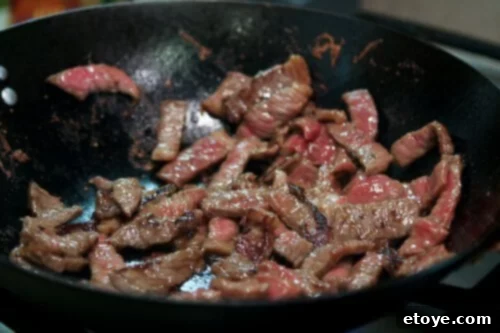
Cooking the Gai-Lan: Achieving Perfect Tenderness and Vibrant Color
With the perfectly cooked and caramelized beef now resting, it's the opportune moment for the vibrant Chinese Broccoli (Gai-Lan) to take center stage. Return to your wok or frying pan, ensuring it maintains a high, consistent heat. Introduce the gai-lan and initiate a brisk stir-fry for approximately one minute. During this initial phase, it is essential to actively scrape up any residual oils and intensely flavorful bits that have adhered to the bottom of the wok, ensuring they thoroughly coat the Chinese broccoli. This crucial step imbues the vegetable with the rich, savory essences left behind by the beef, enhancing its flavor profile significantly.
Following this quick, high-heat stir-fry, reduce the heat to medium-low. Carefully pour approximately 1/4 cup of water or a rich chicken/vegetable broth into the wok, then immediately cover it with a tightly fitting lid. This strategic steaming process is absolutely vital for tenderizing the gai-lan effectively while meticulously preserving its vibrant green color and retaining a pleasant, slight crunch. Allow it to steam gently for a couple of minutes. To accurately assess for perfect doneness, simply pierce a stem with the tip of a knife; it should pass through effortlessly with minimal resistance, signaling ideal tenderness without becoming overly soft or mushy. Once cooked to perfection, transfer the gai-lan to the plate alongside the beef, ensuring all components are prepared and ready for the grand final assembly of your stir-fry masterpiece.



The Grand Finale: Marrying Noodles with Flavorful Sauce
With the beef and gai-lan now expertly cooked and patiently awaiting their reunion, it is the perfectly prepared noodles' turn to command the stage and fully absorb the rich, savory flavors that will ultimately bring this magnificent dish to life. With the wok emptied of its previous contents (except for any delicious residue), add the remaining cup of stock along with the final two tablespoons each of soy sauce, oyster sauce, and rice wine. Bring this exquisite sauce to a vigorous boil over high heat, allowing it a brief moment to slightly reduce and intensify its already profound flavors.
Once the sauce is simmering enthusiastically, carefully introduce your par-cooked noodles into the bubbling mixture in the wok. Toss them vigorously and thoroughly, ensuring that every single strand is completely coated in the fragrant, rich sauce. Continue to cook, stirring frequently to prevent sticking, until the liquid has almost entirely evaporated. The precise objective here is to leave the noodles lightly moistened and perfectly al dente, having successfully absorbed all the succulent, savory essences and nuanced flavors from the wok. This crucial step typically requires just 2 to 3 minutes, effectively adding the ultimate layer of flavor and perfecting the texture of your chosen noodles.
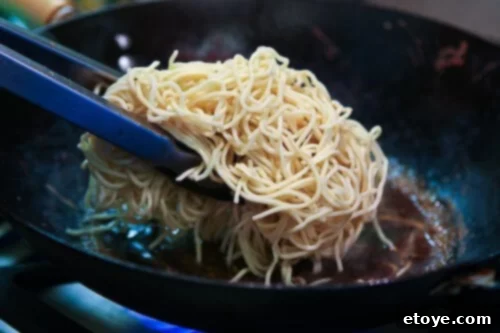
Observe closely as the noodles eagerly absorb all the juicy bits and vibrant flavors from the rich, aromatic sauce, transforming into a deeply satisfying base for your stir-fry:

Assembling and Serving Your Culinary Masterpiece
With the noodles now perfectly infused with flavor and possessing an ideal texture, it's time for the harmonious integration of all the meticulously prepared components. Gently return the beautifully caramelized beef and the tender, vibrant Chinese broccoli to the wok, reuniting them with the flavorful noodles. Toss everything with a gentle yet thorough motion, ensuring that all ingredients are intimately combined and uniformly coated in the remaining delectable sauce. This critical final toss artfully unites the distinct textures and complementary flavors of each element, culminating in a cohesive, incredibly satisfying, and truly memorable dish. Prior to serving, taste the dish and adjust seasoning with freshly ground black pepper to your personal preference, adding a final aromatic flourish. Serve immediately, piping hot, to experience this stir-fry at its absolute peak of flavor and texture.
This Chinese Broccoli Beef Noodle Stir Fry transcends the definition of a mere meal; it is a heartfelt celebration of fresh, high-quality ingredients married with masterful cooking techniques. Every bite offers a delightful symphony of savory, sweet, and umami notes, creating an experience that is both comforting and exhilarating. Savor the gratifying outcome of your culinary endeavors!

Absolutely delicious and undeniably satisfying!
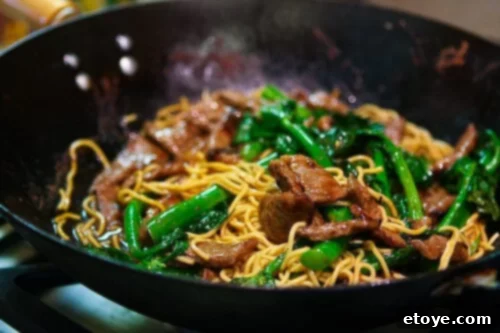

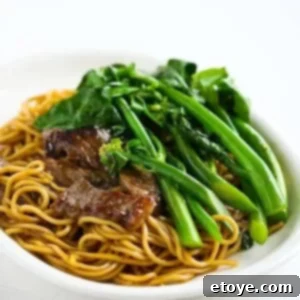
Chinese Broccoli Beef Noodle Stir Fry Recipe
Pin Recipe
Ingredients
- 3 tablespoons soy sauce
- 3 tablespoons oyster sauce
- 3 tablespoons Shaoxing wine, sake or dry white wine
- 1 tablespoon sugar
- 1 tablespoon tapioca starch or cornstarch
- 1 teaspoon dark sesame oil
- 1 pound beef sirloin, thinly sliced
- 1 pound fresh or 10 ounces dried noodles
- 2 tablespoons vegetable oil
- 3 large cloves garlic, crushed and finely chopped
- 1.25 cups chicken or vegetable stock
- 1 pound Chinese broccoli or regular common broccoli, cut into bite-size chunks or florets
- Freshly ground black pepper, to taste
Instructions
- In a medium bowl, whisk together 1 tablespoon each soy sauce, oyster sauce and rice wine. Add the sugar and continue to whisk until completely dissolved. Stir in the tapioca starch and continue stirring until smooth. Add the sesame oil and beef, and mix well. Marinate for 20 minutes. Drain and discard the excess marinade.
- Bring a large pot of water to a boil. Cook the noodles until 1 minute shy of done and drain. (We'll finish cooking the noodles at the end).
- Heat 1 tablespoon of the vegetable oil in a skillet or wok over high heat and stir-fry the garlic until fragrant, about 10 seconds. Add the beef and stir-fry until tender, 1 to 2 minutes. Transfer to a plate. Add the remaining tablespoon of oil and when hot, add the Chinese broccoli, stir frying so that the oil coats the Chinese broccoli. Pour in the 1/4 cup of the stock, turn the heat to medium-low and cover with a tight fitting lid. Cook the Chinese broccoli until tender, 3 to 5 minutes. Transfer the Chinese broccoli to the same plate.
- Add the remaining cup of stock and the remaining 2 tablespoons each of soy sauce, oyster sauce, and rice wine to the same skillet and bring to a boil over high heat.
- Add the noodles and cook until the liquid has almost completely evaporated, leaving the noodles lightly moistened, 2 to 3 minutes. Return the beef and broccoli to the skillet and toss to mix the ingredients thoroughly. Season with pepper to taste and serve.
Notes
This recipe is adapted from Noodles Every Day, a fantastic resource for noodle enthusiasts seeking to explore diverse noodle dishes.
Tried this recipe?
Let us know how it was!
